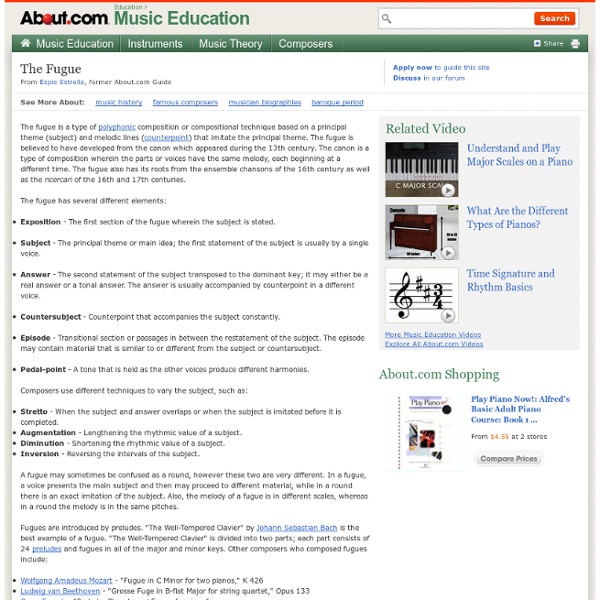The Fugue - The Baroque Fugue

http://musiced.about.com/od/historyofmusic/a/fugues.htm
The Classical Fugue Information Page on Classic Cat
In music, a fugue (pronounced /ˈfjuːɡ/ fewg) is a contrapuntal composition in two or more voices, built on a subject (theme) that is introduced at the beginning in imitation and recurs frequently in the course of the composition. In addition to this broad general contrapuntal design, certain formal characteristics are well established. A fugue usually has three sections: an exposition, a development, and a recapitulation containing the return of the subject in the fugue's tonic key, though not all fugues have a recapitulation.[1] In the Middle Ages, the term was widely used to denote any works in canonic style; by the Renaissance, it had come to denote specifically imitative works.[2] Since the 17th century,[3] the term fugue has described what is commonly regarded as the most fully developed procedure of imitative counterpoint.[4] Musical outline The exposition Example of a tonal answer in J.S.
Fugue
The English term fugue originated in the 16th century and is derived from the French word fugue or the Italian fuga. This in turn comes from Latin, also fuga, which is itself related to both fugere ("to flee") and fugare ("to chase").[1] The adjectival form is fugal.[2] Variants include fughetta (literally, "a small fugue") and fugato (a passage in fugal style within another work that is not a fugue).[3] Musical outline[edit]
Bach Art of Fugue Musical Notes
for harpsichord or pedal-harpsichord. Including a note by Isolde Ahlgrimm “The Art of the Fugue” (Die Kunst der Fuge), as its name implies, was intended and effectively provides, a complete treatise on the art of fugal composition, dealing with every type of fugal treatment from the simplest to the most complex. It may be supposed that Bach had intended to have this work published under his instruction.
Baroque and the fugue
One of the most characteristic forms of music of the Baroque era is definitely the complex and polyphonic fugue. It is built of many independent equally important melodies that are masterely combined with each other into an extravaganza of polyphony. The kind of polyphony used in the fugue form is imitative. Imitation can be made strict or not strict, and fugues use the latter form most of the time (strict imitative polyphony is found in a canon). Fugue is therefore a very complex work, as non-strict imitative polyphony requires compositional skills that go beyond simple melody and accompaniment.
Related:
Related:



